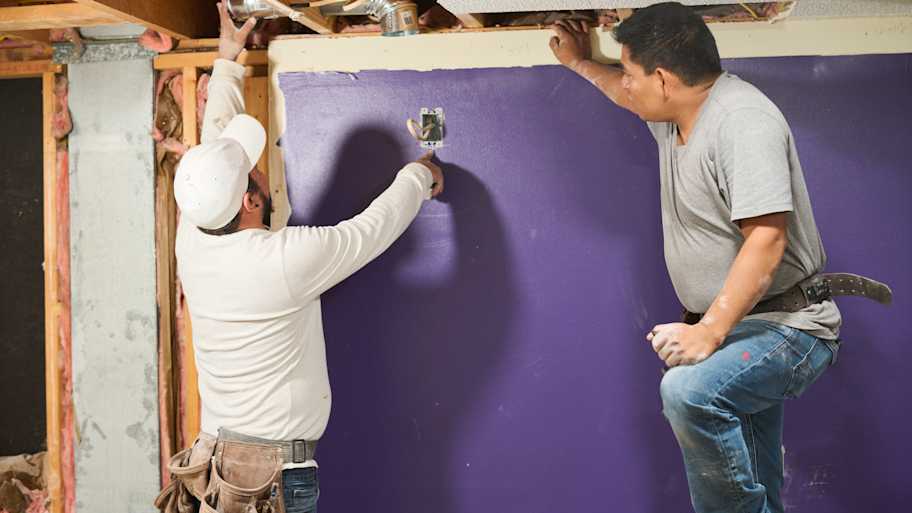What’s the Difference Between Drop Ceilings and Drywall?
Add choosing the right ceiling to the top of your to-do list


Drywall ceiling installation costs between $1.50 and $3.00 per square foot.
Drop ceilings range from $2.00 to $5.00 per square foot.
A drop ceiling is a better fit when sound installation is necessary.
Customizing your home can be a lot of fun, but it also leads to some tough decisions. Choosing between a drop ceiling and a drywall ceiling is a pivotal decision in interior design, impacting aesthetics, functionality, and budget. Drop ceilings, with their suspended grid and removable tiles, offer easy access to utilities like wiring and plumbing. On the other hand, drywall provides a polished, seamless appearance. Let’s dive deeper into the nuances of drop ceilings versus drywall ceilings so you can make an informed choice for your space.
Drop Ceiling vs. Drywall Ceiling: Key Differences
Drop ceiling and drywall ceiling represent distinct approaches to interior finishing. A drop ceiling, or suspended ceiling, consists of a metal grid system supporting removable tiles, allowing easy access to utilities like wiring and plumbing. This type of ceiling is most commonly found in commercial spaces, enhancing acoustics and offering customization options.

In contrast, a drywall ceiling involves the installation of solid panels, creating a seamless, smooth surface. Drywall is favored in homes and upscale establishments for its polished look and ability to hide imperfections. The choice between these two ceiling types essentially hinges on accessibility versus aesthetics—drop ceilings prioritize utility access and adaptability, while drywall ceilings emphasize a flawless, refined appearance.
A ceiling repair specialist can explain the differences between these two options and help you decide which one would work best in your space.
What Is a Drop Ceiling?

A drop ceiling is a secondary ceiling hung below the main structural ceiling. This ceiling type is a grid system that supports removable tiles or panels, which aid in acoustic enhancement.
| Pros | Cons |
|---|---|
| Effortless accessibility | Height limitation |
| Enhanced acoustic control | Dust accumulation |
| Design flexibility | Complex installation |
Best for:
Commercial spaces requiring frequent utility access, such as office buildings and retail stores
Areas where noise reduction and soundproofing are vital, like home libraries, recording studios, and theaters
Environments where aesthetic customization is desired, including upscale restaurants, hotels, and creative workspaces
Pros of a Drop Ceiling
Drop ceilings provide convenient access to essential building systems, enabling quick maintenance and alterations without disrupting the entire ceiling structure. They also excel in noise reduction, creating quieter environments essential for places like classrooms, offices, and conference rooms where acoustics matter. Are you a major design lover? Drop ceilings offer up a myriad of styles, textures, and colors, allowing customization to match any interior aesthetic and enhancing the overall visual appeal.
Cons of a Drop Ceiling
One major downside of a drop ceiling is that this style can lower the overall room height, potentially making spaces with limited vertical clearance feel more confined. The area above drop ceilings can collect dust and allergens, requiring regular cleaning to maintain air quality and prevent respiratory issues.
Setting up a drop ceiling demands meticulous installation, often necessitating professional expertise and time, which can be a drawback for those seeking a quick solution.
What Is a Drywall Ceiling?

Drywall, also known as plasterboard or wallboard, is a widely used building material for interior walls and ceilings. It is composed of gypsum plaster pressed between two thick sheets of paper. Drywall is favored for its smooth finish, providing a polished look to interior spaces.
| Pros | Cons |
|---|---|
| Sleek aesthetic | Vulnerable to moisture |
| Fire resistance | Installation complexity |
| Insulation properties |
Best for:
Homes and apartments where a polished, modern appearance is desired
Spaces where fire safety is a priority, such as residential interiors and commercial buildings
Environments where noise insulation and energy efficiency are important considerations, such as bedrooms and living rooms
Pros of a Drywall Ceiling
When it comes to aesthetics, drywall offers a seamless, polished surface, giving rooms a modern and sophisticated appearance. Its smooth finish is an excellent canvas for various painting and decorative techniques.
Even better than looking good, drywall ceilings have enhanced safety elements. The gypsum in drywall provides inherent fire resistance, making it a safer choice for interior walls, especially in residential buildings where fire safety is a concern. Drywall can also improve thermal insulation, helping maintain a comfortable indoor temperature and reducing energy costs.
Cons of a Drywall Ceiling
Unfortunately, drywall is susceptible to water damage, warping, and mold growth if exposed to moisture. This limitation makes it less suitable for areas prone to leaks or high humidity. Another major downside of drywall ceilings is that achieving a flawless finish requires skillful installation. Inexperienced installations may result in visible seams, requiring additional time and effort to correct imperfections.
Drop Ceiling vs. Drywall Ceiling

Still on the fence when it comes to drywall versus drop ceilings? Which ceiling type is right for your project depends on your priorities. These are some categories in which each ceiling type shines, but you can always hire a ceiling repair specialist in your area if you want an expert opinion.
Appearance: Drywall Ceiling
Drywall ceilings provide a sleek, seamless finish, perfect for contemporary interiors. Unlike drop ceilings, they offer a polished, high-end look, making them a preferred choice for upscale residential projects.
Options and Customizations: Drop Ceiling
Drop ceilings offer various tile textures and colors, allowing customization for unique aesthetics. They are adaptable to diverse designs, making them suitable for commercial spaces with specific interior themes.
Durability: Drywall Ceiling
Drywall ceilings are durable and resistant to wear. However, water can damage them, necessitating precautionary measures in spaces prone to leaks or high humidity. Proper installation and maintenance will enhance the ceiling’s longevity.
Price: Drywall Ceiling
In terms of drop ceiling versus drywall costs, drywall costs less overall. On average, drywall installation costs between $1.50 and $3.00 per square foot, while a drop ceiling costs $2.00 to $5.00 per square foot. Prices can vary based on factors like location, complexity of installation, and materials used.
Soundproofing: Tie
If you’ve ever looked up in a classroom or large office building, you were probably staring at a drop ceiling, and for good reason. Drop ceilings offer sound absorption in large areas, making them a good choice to create a comfortable acoustic environment.
Drywall ceilings also offer sound protection, but they’re more effective in preventing sound from entering or exiting rather than absorbing sound. If soundproofing is a concern, you can choose soundproofing drywall for even more sound control.
Ease of Installation: Drop Ceiling
Drop ceilings are easier to install than drywall ceilings, making them more suitable for DIY projects. The modular nature of drop-ceiling systems allows for convenient assembly, reducing the need for professional installation. On the other hand, drywall ceilings require a skillful installer to avoid imperfections and visible seams.
Ease of Repair: Drop Ceiling
Drop ceilings are also simple to repair and replace, allowing homeowners or maintenance personnel to address issues promptly. Damaged tiles or panels can be swapped out without extensive expertise, simplifying repairs.
Maintenance: Drywall Ceiling
Drywall comes out ahead on maintenance, but only by a little because it depends on the circumstances. Drywall doesn’t require major maintenance, other than cleaning and small repairs, but damaged drywall is more difficult to repair than a drop ceiling.
Drop ceilings can accumulate dust and allergens between the panels and the structural ceiling, and you should schedule regular cleanings to keep this area clean. But if a drop ceiling is damaged by water or other issues, the damaged panels can be replaced easily without requiring a large repair project.















